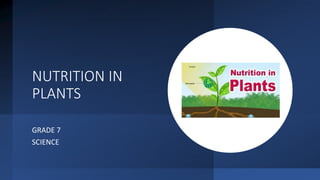
Nutrition in plants
- 2. NUTRITION Carbohydrates, proteins, fats, vitamins and minerals are important for the growth of our body. These components of food are called nutrients. The process of taking in food by an organism and its utilization by the body is called nutrition. We obtain the energy from food by two processes, that is, nutrition and respiration.
- 4. Autotrophic Green plants are able to prepare their own food. by absorbing carbon dioxide from the air and water and minerals from the soil. Plants get the energy for preparing food from sunlight. This mode of nutrition where green plants make food themselves from simple substances is called autotrophic nutrition. Green plants are therefore called autotrophs.
- 5. PHOTOSYNTHESIS IN PLANTS Carbon Dioxide H2O- WATER O2-OXYGEN
- 6. PHOTOSYNTHESiS Photosynthesis in Plants •The cells of green leaves and young stems of plants contain numerous green structures called chloroplasts. •The chloroplasts are green because of the presence of a green pigment called chlorophyll. •It is chlorophyll that traps energy from sunlight. •Leaves take in carbon dioxide from the air through tiny pores called stomata. These pores are located on the underside of the leaves.
- 7. •The stomata are surrounded by guard cells. The guard cells control opening or closing of stomata. •The water is absorbed from the soil by the root hairs present in roots. The water and minerals absorbed by the plants are transported to leaves through xylem vessels that are like pipes. These pipes run through the root, stem, branches and leaves. •Using the energy from the sun, a chemical reaction takes place in the green parts of the plant, in which carbon dioxide and water are converted into food in the form of glucose. Oxygen is released in the process. •Since the synthesis of food occurs in the presence of sunlight, it is called photosynthesis. •The food synthesized by the green leaves is transported to the other parts of the plant by the stem. In most plants, glucose is converted into starch and stored in leaves, stems, roots, etc.
- 8. SYNTHESIS of food by Plants Carbohydrates that plants synthesize during photosynthesis are made up of carbon, hydrogen and oxygen. These are used to synthesize other components of food such as proteins and fats. Proteins contain nitrogen. Though air contains large amounts of nitrogen, plants cannot absorb this nitrogen directly. They get nitrogen in two ways:Soil contains certain bacteria called Rhizobium that can convert atmospheric nitrogen into water-soluble compounds. Plants absorb these compounds along with water to get nitrogen. Farmers add fertilizers rich in nitrogen to the soil. These are absorbed by plants.
- 9. HETROTROPHIC NUTRITION • What is heterotrophic nutrition? Animals and non-green plants, such as fungi and bacteria, cannot prepare their own food. They depend directly or indirectly on green plants for their nutrition. This mode of nutrition is called heterotrophic nutrition. Animals and non-green plants are known as heterotrophs. • Herbivorous animals depend directly on plants for their nutrition. Carnivores depend on other animals, which in turn depend on plants. Thus, when we eat meat, we are indirectly depending on food prepared by plants. • Since green plants get the energy to prepare food from the Sun. Thus, the Sun is the ultimate source of energy for all living organisms.
- 10. Parasitic Plants • Some non-green plants live in or on other living organisms, get food from them. • Example, dodder is a plant that sucks food from another plant. • Such plants are called Parasitic Plants
- 11. Partial Parasites • The plant from which a parasite gets its food is called a host. • Some parasitic plants like mistletoe plant, which grow on trees such as mango or mahua, have green leaves and can synthesize their food. • They take water and minerals from the host plants. • They are known as partial parasites.
- 12. INSECTIVOROUS PLANTS Some plants such as Venus flytrap and pitcher plant grow in soil that is not so rich. They consume insects and use the nutrition obtained from insects to supplement the food they prepare by photosynthesis. Such plants are known as insectivorous plants.
- 13. • In the pitcher plant, a leaf becomes modified to form a pitcher-like structure with a lid. • Inside the pitcher there are hairs pointing downwards. • When an insect enters in the pitcher plant, the lid closes to trap the insect, and it gets entangled in the hair. • The cells of the pitcher plant secrete digestive juices to digest the insect.
- 14. SAPROTROPHS
- 15. • They secrete digestive juices on the dead and decaying matter. • This converts the solid matter into a liquid. • They then absorb the nutrients from this liquid. • This method of getting nutrients from dead and decaying matter in the form of a liquid is known as saprotrophicnutrition.
- 16. • Fungi and bacteria that use this mode of nutrition are known as saprotrophs or saprophytes. • Spores of fungi are always floating around in the air. • They start germinating when they land on wet and warm things. • Fungi grow on shoes, clothes, pickles and other articles in warm and humid weather.
- 17. SYMBIOSIS In symbiosis, two different kinds of organisms work together for their mutual benefit. For example, alga, which is an autotroph, and fungus, which is a saprophyte, live together in lichen. The fungus supplies water and minerals to the cells of the alga, while the alga supplies food to the fungus. This mutually beneficial relationship is called symbiosis.